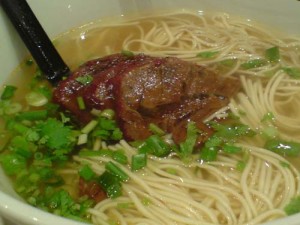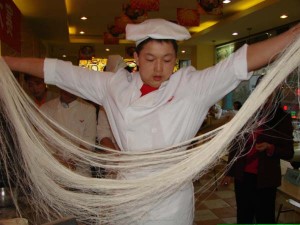Everything But the Table: Lā Miàn Noodles (拉面) Posted by Stephen on Oct 25, 2011 in Culture
 As temperatures continue to plummet, the prospect of finding something hot and spicy to warm your belly becomes all the more appealing. If it wasn’t for today’s elegant yet simplistic dish, 拉面 (lā miàn) or pulled noodles, I don’t know how I could weather the frigid Beijing winter as it approaches.
As temperatures continue to plummet, the prospect of finding something hot and spicy to warm your belly becomes all the more appealing. If it wasn’t for today’s elegant yet simplistic dish, 拉面 (lā miàn) or pulled noodles, I don’t know how I could weather the frigid Beijing winter as it approaches.
So if you want to stay warm, add this dish to your culinary repertoire. These noodles are the ultimate comfort food and a favorite of just about everyone I’ve met (among both foreigners and Chinese people). To quote Kung Fu Panda, “we are noodle folk”.
Much like its Japanese equivalent, ramen, 拉面 is an ancient practice of literally “pulling” noodle apart from one big chunk of starch. Hence the transliteration: “pull noodle”. Watching a 拉面 noodle master go to work is much like watching an Italian chef hand toss a pizza crust; involving an amazing slight of hand and strength that includes a little entertainment for the salivating audience.
As the noodles-to-be flip, slap and twist under the direction of the chef’s nimble hands, you can’t help but wonder how many hours were spent perfecting this doughy dance. Check out the video below:
Much like, 串儿 (chuànr) and 饺子 (jiǎo zi),拉面 is simplistic and comforting food, that sells for cheap (便宜 pián yi) and cures what ails you. While its roots trace back to central Asia, 拉面 has worked its way east through western provinces of China, namely 新疆 (xīn jiāng) and 兰州 (lán zhōu). Eventually the mixture of basic, easily found ingredients, strong spices and availability to all income classes, brought the appeal of 拉面 east, where it has been a staple of Chinese food since.
For a meager price, a big, piping hot bowl is all yours. Usually 拉面 is a mixture of cilantro-like greens, bamboo shoots or tofu, chicken stock, green peppers (青椒) and strips of beef. You may be wondering to yourself: So what? Basically it’s chicken noodle soup, right? Wrong. Just like dumplings, the 拉面 eating experience is all up to what you put into it, literally.
Spicy 辣椒 sauce is always available along with vinegar or 醋 (cù) and fresh greens (parsley/cilantro). Even soy sauce or 酱油 (jiàng yóu) available at most restaurants, if you want that extra salty kick. Just mix it into your bowl until you’ve found that perfect, almost scientifically measured concoction that touches on all five basic tastes. That being said, you can always experiment with your 拉面, or even take your dining experience to extremes. Once I saw a man eating a bowl of 拉面 so bright red with 辣椒 (chili sauce) that he was visibly in pain, yet still methodically slurping away (he later said it was a sure fire way to cure the common cold or 感冒gǎn mào).
On a cold day, there’s nothing better than a steaming hot bowl of 拉面 to warm your belly. All you need to do is find a restaurant with “兰州拉面” on the front, grab a chair, and ask for 一碗 (yiwǎn). Within minutes order will be up. Throw in some spices, grab a beer or 啤酒 (pí jiǔ) and between slurps, ask yourself why you ever would take Mcdonalds or KFC over this fast food delicacy.
After you’ve gone to town, take a second to pull your face out of your bowl and take a look around you. The laughter, slurps and crowds should be proof enough that China is a nation of noodle folk. Just be forewarned that on a particularly cold day, you may not even be able to get a seat.
Follow Steve on twitter: @seeitbelieveit

Build vocabulary, practice pronunciation, and more with Transparent Language Online. Available anytime, anywhere, on any device.
About the Author: Stephen
Writer and blogger for all things China related. Follow me on twitter: @seeitbelieveit -- My Background: Fluent Mandarin speaker with 3+ years working, living, studying and teaching throughout the mainland. Student of Kung Fu and avid photographer and documentarian.





Leave a comment: